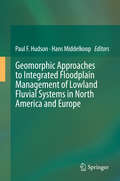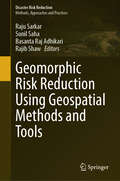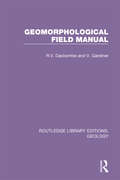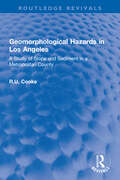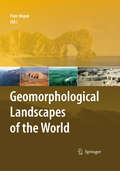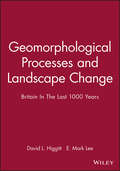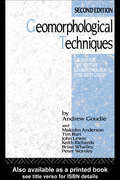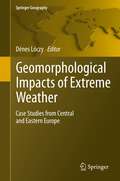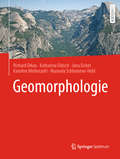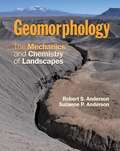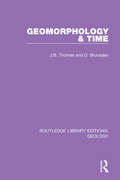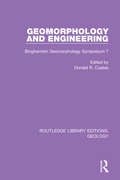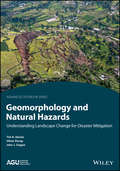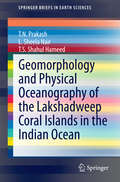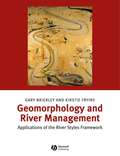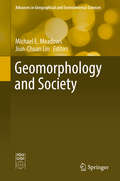- Table View
- List View
Geomorphic Approaches to Integrated Floodplain Management of Lowland Fluvial Systems in North America and Europe
by Paul F. Hudson Hans MiddelkoopThis volume provides a comprehensive perspective on geomorphic approaches to management of lowland alluvial rivers in North America and Europe. Many lowland rivers have been heavily managed for flood control and navigation for decades or centuries, resulting in engineered channels and embanked floodplains with substantially altered sediment loads and geomorphic processes. Over the past decade, floodplain management of many lowland rivers has taken on new importance because of concerns about the potential for global environmental change to alter floodplain processes, necessitating revised management strategies that minimize flood risk while enhancing environmental attributes of floodplains influenced by local embankments and upstream dams. Recognition of the failure of old perspectives on river management and the need to enhance environmental sustainability has stimulated a new approach to river management. The manner that river restoration and integrated management are implemented, however, requires a case study approach that takes into account the impact of historic human impacts to the system, especially engineering. The river basins examined in this volume provide a representative coverage of the drainage of North America and Europe, taking into account a range of climatic and physiographic provinces. They include the 1) Sacramento (California, USA), 2) San Joaquin (California), 3) Missouri (Missouri, USA), 4) Red (Manitoba, Canada and Minnesota, USA), 5) Mississippi (Louisiana, USA), 6) Kissimmee (Florida, USA), 7) Ebro (Spain), 8) Rhone (France), 9) Rhine (Netherlands), 10) Danube (Romania), and 11) Volga (Russian Federation) Rivers. The case studies covered in these chapters span a range of fluvial modes of adjustment, including sediment, channel, hydrologic regime, floodplains, as well as ecosystem and environmental associations.
Geomorphic Risk Reduction Using Geospatial Methods and Tools (Disaster Risk Reduction)
by Rajib Shaw Basanta Raj Adhikari Raju Sarkar Sunil SahaThis book explores the use of advanced geospatial techniques in geomorphic hazards modelling and risk reduction. It also compares the accuracy of traditional statistical methods and advanced machine learning methods and addresses the different ways to reduce the impact of geomorphic hazards.In recent years with the development of human infrastructures, geomorphic hazards are gradually increasing, which include landslides, flood and soil erosion, among others. They cause huge loss of human property and lives. Especially in mountainous, coastal, arid and semi-arid regions, these natural hazards are the main barriers for economic development. Furthermore, human pressure and specific human actions such as deforestation, inappropriate land use and farming have increased the danger of natural disasters and degraded the natural environment, making it more difficult for environmental planners and policymakers to develop appropriate long-term sustainability plans. The most challenging task is to develop a sophisticated approach for continuous inspection and resolution of environmental problems for researchers and scientists. However, in the past several decades, geospatial technology has undergone dramatic advances, opening up new opportunities for handling environmental challenges in a more comprehensive manner.With the help of geographic information system (GIS) tools, high and moderate resolution remote sensing information, such as visible imaging, synthetic aperture radar, global navigation satellite systems, light detection and ranging, Quickbird, Worldview 3, LiDAR, SPOT 5, Google Earth Engine and others deliver state-of-the-art investigations in the identification of multiple natural hazards. For a thorough examination, advanced computer approaches focusing on cutting-edge data processing, machine learning and deep learning may be employed. To detect and manage various geomorphic hazards and their impact, several models with a specific emphasis on natural resources and the environment may be created.
Geomorphological Field Manual (Routledge Library Editions: Geology #12)
by R. Dackombe V. GardinerThis book, first published in 1983, incorporates a wealth of reference material – keys, nomograms, tables, charts – likely to be needed in the field for actual fieldwork. The widest possible coverage of material is provided in anticipation of problems that individual specialists will encounter on the periphery of their main areas of interest.
Geomorphological Hazards and Disaster Prevention
by Andrew S. Goudie Irasema Alcántara-AyalaHuman activities have had a huge impact on the environment and landscape, through industrialisation and land-use change, leading to climate change, deforestation, desertification, land degradation, and air and water pollution. These impacts are strongly linked to the occurrence of geomorphological hazards, such as floods, landslides, snow avalanches, soil erosion, and others. Geomorphological work includes not only the understanding but the mapping and modelling of Earth's surface processes, many of which directly affect human societies. In addition, geomorphologists are becoming increasingly involved with the dimensions of societal problem solving, through vulnerability analysis, hazard and risk assessment and management. The work of geomorphologists is therefore of prime importance for disaster prevention. An international team of geomorphologists have contributed their expertise to this volume, making this a scientifically rigorous work for a wide audience of geomorphologists and other Earth scientists, including those involved in environmental science, hazard and risk assessment, management and policy.
Geomorphological Hazards in Los Angeles: A Study of Slope and Sediment in a Metropolitan County (Routledge Revivals)
by R.U. CookeThis book, first published in 1984, deals authoritatively with the nature and management of slope failures and sediment movement and their impact on the hazardous landscape of Los Angeles county. Bringing together for the first time a wide range of information derived from field observations, interviews, manuscript records, local agency reports and published sources, the book presents an analysis of the ways in which a rapidly developing metropolis has come to terms with complex geomorphological hazards. In particular, the events accompanying the major storms of 1914, 1934, 1969 and 1978 are reconstructed in detail.
Geomorphological Landscapes of the World
by Piotr MigonPhysical landscapes are one of the most fascinating facets of our Planet, which tell stories about the evolution of the surface of the Earth. This book provides up-to-date information about the geomorphology of the selected 'classic' sites from around the world and shows the variety of geomorphological landscapes as moulded by different sets of processes acting over different timescales, from millions of years to days. The volume is written by nearly fifty geomorphologists from more than twenty countries who for many years have researched some of the unique sceneries on the planet. The thirty six chapters present each continent of the world. They describe landscapes of different origin, so that the reader can learn about the complexity of processes behind the sceneries. This is a useful reference book, linking geomorphology with global initiatives focused on nature conservation.
Geomorphological Processes and Landscape Change: Britain In The Last 1000 Years (RGS-IBG Book Series #69)
by David L. Higgitt E. Mark LeeThe expert contributors to this cutting edge volume provide an overview of geomorphological process activity and landscape change in Britain over the past 1000 years. The range of the book is unusually broad, encompassing hillslope, valley floor and floodplain, fluvial, estuarine and coastal processes. Provides an overview of geomorphological process activity and landscape change in Britain over the past 1000 years. The range of the book is unusually broad, encompassing hillslope, valley floor and floodplain, fluvial, estuarine and coastal processes. Considers the relevance of technological and conceptual approaches to understanding landscape dynamics. Examines key process environments highlighting significant trends and the influence of human activity, and incorporating examples and modelling. Encourages geographers to look forward to the challenges that geomorphology faces in the new millennium. Find out more information about the RGS-IBG journals by following the links below: AREA: http://www.blackwellpublishing.com/journal.asp?ref=0004-0894 The Geographical Journal: http://www.blackwellpublishing.com/journal.asp?ref=0016-7398 Transactions of the Insititute of British Geographers: http://www.blackwellpublishing.com/journal.asp?ref=0020-2754
Geomorphological Techniques
by Andrew GoudieThe specialist contributors to Geomorphological Techniques have thoroughly augmented and updated their original, authoritative coverage with critical evaluations of major recent developments in this field. A new chapter on neotectonics reflects the impact of developments in tectonic theory, and heavily revised sections deal with advances in remote sensing, image analysis, radiometric dating, geomorphometry, data loggers, radioactive tracers, and the determination of pore water pressure and the rates of denudation.
Geomorphological impacts of extreme weather
by Denes LoczyThis book presents new research on the geomorphological impacts of extreme precipitation events. It focuses on the extreme summer floods, which affected Central and Eastern Europe in 2010. Case studies on their consequences, including inundations, urban flooding, soil erosion, river bank retreat, alluvial fan accumulation, evolution of karst depressions, debris flows, landslides and soil saturation are presented for Poland, the Czech Republic, Ukraine, Slovakia, Hungary, Romania, Slovenia, Croatia, Serbia, Bulgaria and Macedonia. This key applied geomorphology book is crucial for anyone interested in these processes and their consequences and also for decision makers who face these catastrophes.
Geomorphologie: Proceedings Of The Walter F. Wood Memorial Symposium, 3rd International Conference On Geomorphology, Mcmaster University, Hamilton, Ontario, Canada, August 23-28, 1993 (Zeitschrift Für Geomorphologie Ser. #Vol. 101)
by Richard Dikau Katharina Eibisch Jana Eichel Karoline Meßenzehl Manuela Schlummer-HeldDieses Lehrbuch vermittelt Ihnen Einblicke, wie Gletscher, Bergstürze, Flüsse oder Vulkanausbrüche die Reliefformen unserer Erde erschaffen, verändern und zerstören. Sie erfahren, welch außerordentliche Vielzahl der von Menschen unberührten natürlichen Prozesse an der Formung der Erdoberfläche mitwirken. Unser Buch hilft Ihnen, diese Vielfalt zu ordnen und in eine übersichtliche Systematik zu bringen. Die einzelnen Prozesse und Formen werden in Grundzügen beschrieben und mit zahlreichen fotographischen Beispielen dokumentiert. Daneben bieten wir Ihnen allgemeine Grundlagen für das Verständnis der reliefformenden Prozesse, wie die Art und Weise der Wissensgewinnung oder die Entwicklungsgeschichte der Reliefformen. Um Ihnen einen Einblick in die Praxis des wissenschaftlichen Arbeitens zu geben, haben wir zwei Fallstudien in das Lehrbuch aufgenommen. Sie zeigen exemplarisch, welche Konsequenzen die menschlichen Eingriffe in die Reliefformen bewirken können und welche Folgen in Zukunft möglich sind. Wir erhoffen uns, dass dieses Lehrbuch Wissen vermittelt, Fragen beantwortet, den Blick auf unsere Erdoberfläche schärft und Leidenschaften für die natürlichen Reliefformen weckt. Als Bestandteil des Naturschönen bilden sie Erscheinungen, die es zu erhalten und zu schützen gilt.
Geomorphology
by Robert S. Anderson Suzanne P. AndersonThis textbook provides a modern, quantitative and process-oriented approach to equip students with the tools to understand geomorphology. Insight into the interpretation of landscapes is developed from basic principles and simple models, and by stepping through the equations that capture the essence of the mechanics and chemistry of landscapes. Boxed worked examples and real-world applications bring the subject to life for students, allowing them to apply the theory to their own experience. The book covers cutting edge topics, including the revolutionary cosmogenic nuclide dating methods and modeling, highlights links to other Earth sciences through up-to-date summaries of current research, and illustrates the importance of geomorphology in understanding environmental changes. Setting up problems as a conservation of mass, ice, soil, or heat, this book arms students with tools to fully explore processes, understand landscapes, and to participate in this rapidly evolving field.
Geomorphology & Time (Routledge Library Editions: Geology #15)
by J.B. Thornes D. BrunsdenTime is a central feature of geomorphological research, and is used in this book (first published in 1977) to provide a conceptual framework within which to consider and compare old and new approaches to the field of geomorphology. The emphasis is on providing not merely a manual of current research but an introduction to isolate ideas and concepts, stimulate critical discussion and examine some of the problems that are involved in dealing with data.
Geomorphology and Engineering: Binghamton Geomorphology Symposium 7 (Routledge Library Editions: Geology #14)
by Donald R. CoatesWhether the project is river engineering, soil mapping for landuse planning, or control of landslides, this volume, first published in 1976, illustrates that the professional partnership between geomorphology and engineering can significantly minimize environmental damage. The papers here were presented at the 7th Binghamton Geomorphology Symposium, and using the broad viewpoint of the planner, much new ground is covered: landfill design, prediction of geomorphic processes and their effects, and minimization of streamflow distortion.
Geomorphology and Natural Hazards: Understanding Landscape Change for Disaster Mitigation (AGU Advanced Textbooks)
by John J. Clague Timothy R. Davies Oliver KorupNatural disasters are occasional intense events that disturb Earth's surface, but their impact can be felt long after. Hazard events such as earthquakes, volcanos, drought, and storms can trigger a catastrophic reshaping of the landscape through the erosion, transport, and deposition of different kinds of materials. Geomorphology and Natural Hazards: Understanding Landscape Change for Disaster Mitigation is a graduate level textbook that explores the natural hazards resulting from landscape change and shows how an Earth science perspective can inform hazard mitigation and disaster impact reduction. Volume highlights include: Definitions of hazards, risks, and disasters Impact of different natural hazards on Earth surface processes Geomorphologic insights for hazard assessment and risk mitigation Models for predicting natural hazards How human activities have altered 'natural' hazards Complementarity of geomorphology and engineering to manage threats
Geomorphology and Physical Oceanography of the Lakshadweep Coral Islands in the Indian Ocean
by T. N. Prakash L. Sheela Nair T.S. Shahul HameedThe Lakshadweep islands are a group of 36 coral islands in the Indian Ocean. These small islands are unique for their aquatic bio-diversity and vast blue lagoons. This book presents the results of studies done by the authors during the period 1990 to 2009 that address the beach morphology, hydrodynamics, energy resources and management options with special reference to the issue of both natural and anthropogenic coastal erosion. The relatively low island elevation makes the islands more susceptible to high-wave attack and coastal flooding during adverse weather conditions. The islands are also prone to risks from episodic events like cyclones and deep depressions. This highlights the need for a comprehensive study of the wave, climate and coastal processes at work during different seasons to delineate the factors responsible for shoreline changes and also to identify the locations that need protection and the management options. This book will serve as a guide to researchers, scholars and students who are interested in the coastal processes of coral islands.
Geomorphology and River Management: Applications of the River Styles Framework
by Gary J. Brierley Kirstie A. FryirsThis book outlines a generic set of procedures, termed the River Styles Framework, which provides a set of tools for interpreting river character, behavior, condition, and recovery potential. Applications of the framework generate a coherent package of geomorphic information, providing a physical template for river rehabilitation activities. management and restoration of rivers is a rapidly growing topic for environmental scientists, geologists and ecologists - this book provides a learning tool with which to approach geomorphic applications to river management describes the essential geomorphological principles underlying river behaviour and evolution demonstrates how the River Styles Framework can turn geomorphic theory into practice, to develop workable strategies for restoration and management based on real case studies and authors extensive experience applicable to river systems worldwide synthesises fluvial geomorphology, ecology and management
Geomorphology and Society
by Michael E. Meadows Jiun-Chuan LinThisbook deals with the relationship between geomorphology and society. This topic hashad rather scant treatment in the literature except to some extent under thelabel "applied geomorphology". In this text the authors aim to bring togetherconceptual issues and case studies of how geomorphology influences society and,indeed, how society is in turn influenced by geomorphology. In an age in whichthe influence of human activities on global environments has become soparamount that it is increasingly common to refer to it geologically as the "anthropocene",the book aims to reflect on the geomorphological significance of widespread anddiverse forms of human impact in a range of environmental settings.
Geomorphology and Soils (Routledge Library Editions: Geology #16)
by K. S. RichardsSoils and sediments influence current processes, preserve evidence of past processes, indicate evolutionary phases in landscapes and provide a basis for relative and absolute chronologies. They provide an important key to the integration of short-term process studies and investigation of longer-term landform evolution. This book, first published in 1985, has been arranged to provide wide temporal and spatial coverage, with studies ranging from historic to geologic time scales and micro- to macro-spatial scales. The interdisciplinary nature of the subject is reflected in contributions from soil scientists, engineering geologists, hydrologists and geomorphologists.
Geomorphology and the Carbon Cycle (RGS-IBG Book Series)
by Martin EvansThe first systematic examination of the role of geomorphological processes in the cycling of carbon through the terrestrial system. Argues that knowledge of geomorphological processes is fundamental to understanding the ways in which carbon is stored and recycled in the terrestrial environment Integrates classical geomorphological theory with understanding of microbial processes controlling the decomposition of organic matter Develops an interdisciplinary research agenda for the analysis of the terrestrial carbon cycle Informed by work in ecology, microbiology and biogeochemistry, in order to analyse spatial and temporal patterns of terrestrial carbon cycling at the landscape scale Considers the ways in which, as Humanity enters the Anthropocene, the application of this science has the potential to manage the terrestrial carbon cycle to limit increases in atmospheric carbon
Geomorphology in Arid Regions: Binghamton Geomorphology Symposium 8 (Routledge Library Editions: Geology #17)
by Donald O. DoehringThis book, first published in 1980, collects together thirteen articles on ‘Geomorphology in Arid Regions’. It uses the term ‘arid’ loosely to include studies from climes which might otherwise be considered semi-arid, in order to provide a diversity of papers dealing with important problems of interest to geomorphologists today.
Geomorphology in Deserts
by Andrew Warren Ronald U. CookeThis title is part of UC Press's Voices Revived program, which commemorates University of California Press’s mission to seek out and cultivate the brightest minds and give them voice, reach, and impact. Drawing on a backlist dating to 1893, Voices Revived makes high-quality, peer-reviewed scholarship accessible once again using print-on-demand technology. This title was originally published in 1973.
Geomorphology in the Anthropocene
by Andrew S. Goudie Viles Heather A.The Anthropocene is a major new concept in the Earth sciences and this book examines the effects on geomorphology within this period. Drawing examples from many different global environments, this comprehensive volume demonstrates that human impact on landforms and land-forming processes is profound, due to various driving forces, including: use of fire; extinction of fauna; development of agriculture, urbanisation, and globalisation; and new methods of harnessing energy. The book explores the ways in which future climate change due to anthropogenic causes may further magnify effects on geomorphology, with respect to future hazards such as floods and landslides, the state of the cryosphere, and sea level. The book concludes with a consideration of the ways in which landforms are now being managed and protected. Covering all major aspects of geomorphology, this book is ideal for undergraduate and graduate students studying geomorphology, environmental science and physical geography, and for all researchers of geomorphology.
Geomorphology of Brazil: XIII SINAGEO (National Symposium of Geomorphology) (Springer Proceedings in Earth and Environmental Sciences)
by Gisele Barbosa dos Santos Miguel Fernandes Felippe Roberto Marques NetoThis book presents the most relevant articles selected from the annals of the symposium. In the last few years, Brazilian Geomorphology has experienced a series of epistemological and methodological innovations expressed by the incorporation of the complexity paradigm, by the progressive break with the climate paradigm, by the emergency role of new theories, and by the advances in methodological fields favored by the adherence to geochronological techniques and in function of the increasingly widespread use of geotechnologies. Furthermore, the Anthropocene/Technogene emerge claims to be more than only a temporal cuts, but as conceptions of a science engaged with social and environmental issues. The National Symposium of Geomorphology, in the maturity of its 13th edition, constitutes a portrait and an important sample of Brazilian geomorphological production, aggregating works carried out in the most diverse types of landscapes of Brazil. The book provides an overview of the current scientific production of Brazilian Geomorphology, highlighting the diversity of landscapes and geoheritage in Brazil, the complexity of the morphogenetic and morphodynamic processes responsible for shaping its surface, and the various abundant methodologies used in geomorphological studies in tropical areas.
Geomorphology of Desert Dunes
by Nicholas LancasterSand dunes are a globally important depositional landform and sedimentary system. Their origins and dynamics are important in understanding how deserts have evolved in response to climate change and changes in sand supply and mobility, and how they will continue to evolve in the future. This book provides a state-of-the-art review of the characteristics of desert dunes and their sediments, and explores their dynamics on timescales from days to millennia as they respond to changes in wind speed and direction, precipitation and sand supply. This extensively revised edition reflects the advances in our understanding of desert dunes, their dynamics and history; and covers recent developments including the luminescence dating revolution, ground penetrating radar and advances in numerical modeling. Also covering dunes on Mars and Titan, this authoritative reference is a must-have for researchers and graduate students working on desert dunes and aeolian geomorphology.
Geomorphology of Desert Dunes
by Nicholas LancasterFirst published in 2004. Routledge is an imprint of Taylor & Francis, an informa company.
